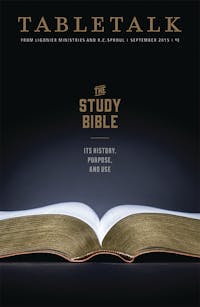
Request your free, three-month trial to Tabletalk magazine. You’ll receive the print issue monthly and gain immediate digital access to decades of archives. This trial is risk-free. No credit card required.
Try Tabletalk NowAlready receive Tabletalk magazine every month?
Verify your email address to gain unlimited access.
A friend of mine has been known to encurage me to produce my own study Bible. Happily, his vision for my study Bible isn’t quite the mammoth undertaking that putting together a real study Bible is. He suggests that my Bible just have a few notes, repeated over and over again. Things like, “See this promise? Believe it.” Or, “This sinner in this story—he’s just like you. Learn to see yourself in the Bible’s great sinners.” These two themes—that we need to learn to believe more fully, down to our toes, the promises of God, and that we need to come to a more potent, existential awareness of our sins and our weaknesses—are a big deal to me. The themes find their way regularly into my writing and into my teaching.
That, in itself, is not a bad thing. Wisdom calls us to recognize, as much as we are able, our own peculiar callings. If God gives you a cannon, He expects you to fire it. There is, however, also a danger. Just as it has been said that to the man with a hammer everything can look like a nail, so when we come to the Bible with our pet passions we will find ourselves tempted to see things in the text that aren’t there, and to miss things in the text that are there. We will show ourselves workmen who need to be ashamed for mishandling the Word of God.
There are, of course, metanarratives to go along with biblical narratives. A narrative, simply put, is a story. A metanarrative is a storythattranscends stories. It is the overarching story. The Boston Tea Party is a narrative. America as a fearless bastion of freedom—that’s a metanarrative. The two, of course intersect, just as they do in the Bible. Abraham and Isaac on Mount Moriah is a story that illumines the metanarrative of substitutionary atonement and of fathers sacrificing sons (see also John 3:16). Nathan’s confrontation of David is a story that illumines the metanarrative of blindness to sin.
Because there are metanarratives, we are wise to see them in the narratives we read. But because there are many, we need to be careful not to put square narratives into round metanarratives. Trouble is, because there is more than one metanarrative, we face the temptation to seek out the metametanarrative, the story that transcends the stories that transcend.
Consider covenant theology and dispensational theology. These big-picture interpretative grids are so broad, so all-encompassing that each side often finds itself struggling to correct the other. Our differences are so foundational, touching on how we understand all of God’s Word that we seemingly have nothing to do but talk past each other. We can’t walk inside each other’s shoes because we’re walking in opposite directions. I have my own convictions on the issue, strong ones. But I’m not afraid to confess that I am virtually uncorrectable from my friends on the other side, simply because this is such a foundational issue.
Which makes me long for an unimpeachable answer, a meta-meta-metanarrative that comes from the lips of Jesus Himself. Is it just possible that all the Bible’s stories about substitution, about covering, about creation, fall, redemption, about covenant are subsumed under one grand story? Perhaps so. What if, in the end, it were all about the kingdom? What if that is why Jesus said, “Seek first the kingdom of God and His righteousness”? What if He was clueing us in on the big picture? What if the dominion mandate, the Great Commission, the promise that all things are being brought into submission to the reign of Christ—what if these were all the one great story?
This doesn’t, of course, undo the other stories in the Bible. It’s still true that the Bible is the story of Jesus’ rescuing not the beautiful princess, but the ugly hag. But in doing so, He secures a queen for His kingdom. It doesn’t undo His death and resurrection for us. But in doing so, He wins citizens for His kingdom. It doesn’t undo creation–fall–re-creation. But it affirms that God created a kingdom, Adam failed to rule it, and Jesus now succeeds where the first Adam failed.
When Jesus calls us to seek first His kingdom, He isn’t turning sanctification, evangelism, sound doctrine, atonement, and meeting the needs of widows and orphans into secondary matters. Rather, He is telling us why we pursue these things, the end for which they exist. It is affirming the forest that helps us understand the trees.
There is, however, one more step. The Bible is only penultimately the story of the kingdom. For the glorious truth is that the kingdom exists for the sake of the King. The Bible is Jesus’ story from beginning to end. He is the Alpha and Omega of the Bible, even as He is the Alpha and Omega of history. We understand history, we understand the Bible, therefore, only insofar as we understand Jesus. That is what each is for: to show us the glory of the Only Begotten, to the everlasting praise of the Father. May we never, in all our study, lose sight of Him.
